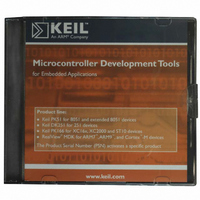MDK-ARM Keil, MDK-ARM Datasheet - Page 16

MDK-ARM
Manufacturer Part Number
MDK-ARM
Description
KIT REALVIEW MCU DEVELOPMENT
Manufacturer
Keil
Type
Compiler and IDEr
Specifications of MDK-ARM
For Use With/related Products
ARM MCUs
Lead Free Status / RoHS Status
Lead free / RoHS Compliant
- Current page: 16 of 156
- Download datasheet (3Mb)
16
Chapter 2. Developing With an RTOS
In the course of this chapter we will consider the idea of using RTX, the Keil
small footprint RTOS, on an ARM processor-based microcontroller. If you are
used to writing procedural-based C code on microcontrollers, you may doubt the
need for such an operating system. If you are not familiar with using an RTOS in
real-time embedded systems, you should read this chapter before dismissing the
idea. The use of an RTOS represents a more sophisticated design approach,
inherently fostering structured code development, which is enforced by the
RTOS Application Programming Interface (API).
The RTOS structure allows you to take an object-orientated design approach
while still programming in C. The RTOS also provides you with multithreaded
support on a small microcontroller. These two features create a shift in design
philosophy, moving us away from thinking about procedural C code and flow
charts. Instead, we consider the fundamental program tasks and the flow of data
between them. The use of an RTOS also has several additional benefits, which
may not be immediately obvious. Since an RTOS-based project is composed of
well-defined tasks, using an RTOS helps to improve project management, code
reuse, and software testing.
The tradeoff for this is that an RTOS has additional memory requirements and
increased interrupt latency. Typically, RTX requires between 500 Bytes and
5KBytes of RAM and 5KBytes of code, but remember that some of the RTOS
code would be replicated in your program anyway. We now have a generation of
small, low-cost microcontrollers that have enough on-chip memory and
processing power to support the use of an RTOS. Developing using this
approach is therefore much more accessible.
Getting Started
This chapter first looks at setting up an introductory RTOS project for ARM7,
ARM9, and Cortex-M based microcontrollers. Next, we will go through each of
the RTOS primitives and explain how they influence the design of our
application code. Finally, when we have a clear understanding of the RTOS
features, we will take a closer look at the RTOS configuration file.
Chapter 2. Developing With an RTOS
Related parts for MDK-ARM
Image
Part Number
Description
Manufacturer
Datasheet
Request
R

Part Number:
Description:
KIT REALVIEW MCU DEVELOPMENT
Manufacturer:
Keil
Datasheet:

Part Number:
Description:
Development Software SUPPORT EXTENSION FOR MDK-ARM-B
Manufacturer:
Keil Software

Part Number:
Description:
Development Software SUPPORT EXTENSION FOR MDK-ARM
Manufacturer:
Keil Software

Part Number:
Description:
KIT REALVIEW MCU DEVELOPMENT
Manufacturer:
Keil
Datasheet:

Part Number:
Description:
Development Software MCU DEV KIT FOR ARM UPG TO FLOATING LIC
Manufacturer:
Keil Tools

Part Number:
Description:
Development Software MCU DEV KIT FOR ARM W/ FLOATING LICENSE
Manufacturer:
Keil Software

Part Number:
Description:
Development Software MCU DEV KIT FOR ARM uVISION & C++ & RTX
Manufacturer:
Keil Tools

Part Number:
Description:
Development Software SUPP LICENSE RENEWAL 90+ DAYS NO TECH SUP
Manufacturer:
Keil Software
Part Number:
Description:
KEIL C-COMPILER INTERNATIONAL
Manufacturer:
Silicon Laboratories Inc

Part Number:
Description:
BOARD EVAL FOR LPC213X ARM MCU
Manufacturer:
NXP Semiconductors
Datasheet:
Part Number:
Description:
K60N512 Keil Tower Kit
Manufacturer:
Freescale Semiconductor
Datasheet:










